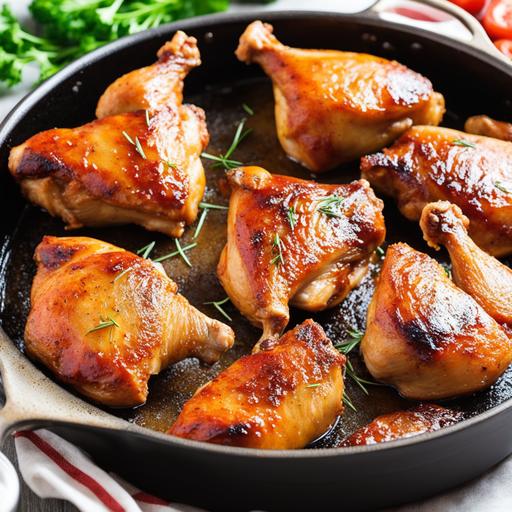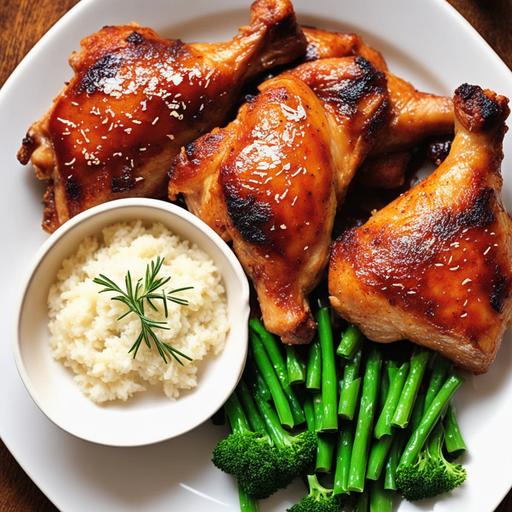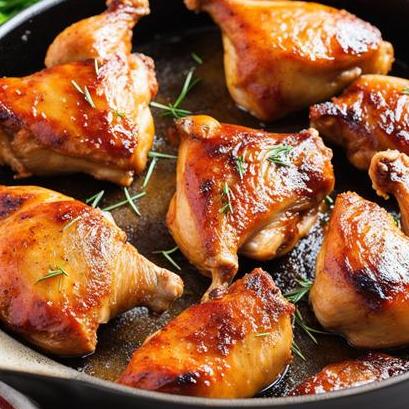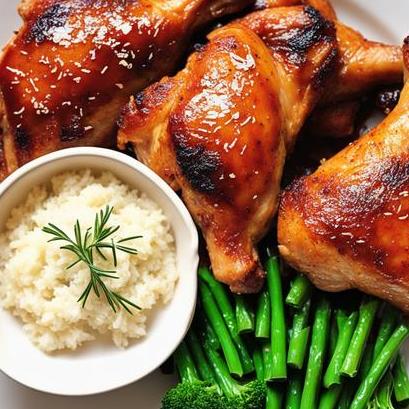
The Ultimate Chicken Thighs And Legs Oven Recipe: A Mouthwatering Delight
When it comes to poultry, chicken thighs and legs stand out as a delectable and versatile choice. With their succulent and juicy texture, they can be cooked in various ways. In this comprehensive article, we will delve into the world of chicken thighs and legs, exploring everything from their food science and culinary details to selection, cleaning, preparation, tips, variations, doneness checks, and even the dreaded possibilities of overcooking or undercooking.
The Science Behind Perfectly Cooked Chicken Thighs and Legs
Before we dive into the culinary details, let’s take a moment to understand the food science behind cooking chicken thighs and legs to perfection. Chicken thighs and legs are dark meat, which means they contain more myoglobin, a protein that stores oxygen and gives the meat its characteristic darker color. The higher concentration of myoglobin contributes to their richer flavor and increased moisture content compared to white meat.
When cooking, chicken thighs and legs benefit from the slow and steady heat of an oven. This gentle heat helps break down the connective tissues and renders the fat within the meat, resulting in tender and moist chicken.
Selection, Cleaning, and Preparation
Selection
When choosing chicken thighs and legs for your recipe, opt for organic or free-range options, as they tend to have better flavor and texture. Look for cuts that are plump and have a healthy pink color, indicating freshness. Ensure there is no unpleasant odor emanating from the chicken, as this might be a sign of spoilage.
Cleaning
Proper sanitation is essential when handling raw chicken. Start by thoroughly washing your hands and sanitizing the preparation area. Rinse the chicken thighs and legs under cold running water, ensuring all surfaces are clean. Pat them dry using paper towels, removing any excess moisture that could hinder proper browning during cooking.
Preparation
To enhance the flavors and ensure even cooking, marinating the chicken thighs and legs is highly recommended. Create a marinade of your choice using herbs, spices, and a complementary liquid like olive oil or yogurt. Let the chicken marinate in the refrigerator for at least 30 minutes or up to overnight to allow the flavors to infuse.
Tips for Perfectly Roasting Chicken Thighs and Legs

Preheating the Oven
Achieving a juicy and tender result starts with proper oven preheating. Set your oven to 375°F (190°C) and allow it to reach the desired temperature before placing the chicken inside. Consistent heat throughout the cooking process is crucial for even cooking.
Proper Seasoning
Take your seasoning game to the next level by generously seasoning the chicken thighs and legs. Mix together a blend of salt, freshly ground black pepper, and your favorite herbs and spices. Rub this mixture all over the chicken, ensuring every nook and cranny is well seasoned.
Basting for Moisture
To elevate the juiciness and flavor profile of your chicken, basting is key. Basting involves brushing the chicken with a liquid during the cooking process to provide moisture and enhance the final taste. A popular basting option is a combination of melted butter and minced garlic, offering richness and depth to the meat.
Achieving Optimal Crispy Skin
Crispy skin is a testament to perfectly roasted chicken thighs and legs. To achieve this coveted texture, start roasting the chicken skin side up. This allows the rendered fat to collect and crisp the skin as it cooks. For an extra crispy finish, you can briefly broil the chicken for a minute or two after roasting.
Variations and Flavor Enhancements

Lemon-Herb Chicken with Thyme and Rosemary
For a fresh and zesty twist, combine the flavors of lemon and fragrant herbs. Squeeze fresh lemon juice over the chicken thighs and legs before seasoning with a mixture of thyme, rosemary, salt, and pepper. The bright citrusy notes perfectly complement the richness of the meat.
Spicy Glazed Barbecue Chicken
If you crave a bit of heat, a spicy glazed barbecue chicken recipe is just what you need. Prepare a tangy barbecue sauce with a hint of chili powder, cayenne pepper, and a touch of sweetness. Brush the sauce over the chicken during the final minutes of cooking, allowing it to caramelize and impart a robust and smoky flavor.
Mediterranean-Inspired Herb and Garlic Chicken
Transport your taste buds to the Mediterranean with a tantalizing blend of herbs and garlic. Create a marinade using olive oil, chopped fresh herbs like oregano and thyme, minced garlic, salt, and pepper. Let the chicken thighs and legs soak up these Mediterranean flavors before roasting to perfection.
Doneness Checks: Avoiding Overcooking and Undercooking

Temperature Monitoring
To ensure your chicken thighs and legs are neither overcooked nor undercooked, investing in a reliable meat thermometer is crucial. Insert the thermometer into the thickest part of the meat, avoiding the bone. Chicken should reach an internal temperature of 165°F (74°C) to be considered safe to eat.
Visual Indicators
Apart from temperature monitoring, visual indicators can also help you determine the doneness of your chicken. The meat should be opaque throughout with no traces of pink, and the juices should run clear. If you notice any pink hues or bloody juices, continue cooking until the desired doneness is achieved.
Recipe: Classic Roasted Chicken Thighs and Legs

Ingredients:
-
4 chicken thighs
-
4 chicken legs
-
2 tablespoons olive oil
-
2 teaspoons salt
-
1 teaspoon freshly ground black pepper
-
1 teaspoon paprika
-
1 teaspoon dried thyme
-
1 teaspoon dried rosemary
-
4 cloves of garlic, minced
Instructions:
-
Preheat the oven to 375°F (190°C).
-
In a small bowl, combine the salt, pepper, paprika, dried thyme, dried rosemary, and minced garlic.
-
Place the chicken thighs and legs on a baking sheet lined with parchment paper or aluminum foil.
-
Drizzle the olive oil over the chicken, ensuring each piece is coated.
-
Sprinkle the seasoning mixture evenly over the chicken, rubbing it all over to ensure thorough coverage.
-
Place the chicken in the preheated oven and roast for approximately 40-45 minutes or until the internal temperature reaches 165°F (74°C).
-
Once cooked, remove the chicken from the oven and let it rest for a few minutes before serving.
The Dreaded Possibilities: Overcooking and Undercooking
While we strive for perfection in our culinary endeavors, occasionally, mishaps occur. Overcooking or undercooking chicken thighs and legs can be disappointing, but fear not! There are ways to salvage these situations.
Overcooking Recovery
If you accidentally overcook the chicken, rescue it by incorporating it into moist dishes such as stews, soups, or casseroles. Utilize sauces and broths to add moisture and counterbalance any dryness in the meat. Shredding the overcooked chicken and incorporating it into tacos or sandwiches can also mask any texture issues.
Undercooking Recovery
In the event of undercooking, finish cooking the chicken thighs and legs by returning them to the oven. Cover the chicken with aluminum foil to prevent excessive browning, and continue cooking until the desired internal temperature of 165°F (74°C) is reached. Always prioritize safety and ensure the meat is thoroughly cooked before serving.
In Conclusion
Congratulations! You have now embarked on a culinary journey exploring the world of chicken thighs and legs in oven recipes. With a solid understanding of the food science, culinary techniques, selection, cleaning, preparation, tips, variations, doneness checks, and even recovery methods, you are equipped to create mouthwatering dishes guaranteed to impress family and friends. So, preheat that oven, savor the aromas, and indulge in the tender and succulent delights of perfectly roasted chicken thighs and legs. Enjoy!
Sources
FAQS On Chicken Thighs And Legs Oven Recipe
What Ingredients Do I Need For A Chicken Thighs And Legs Oven Recipe?
For a basic recipe, you will need chicken thighs and legs, olive oil, salt, pepper, and any desired herbs and spices.
Do I Need To Preheat The Oven Before Cooking The Chicken In It?
Yes, preheating the oven is important to ensure that the chicken cooks evenly and thoroughly. Preheat the oven to 400°F (204°C) for best results.
How Long Do I Need To Cook Chicken Thighs And Legs In The Oven?
The cooking time may vary depending on the size of the chicken pieces and your specific oven. Typically, chicken thighs and legs should be cooked in the oven for 35-45 minutes at 400°F (204°C), or until the internal temperature reaches at least 165°F (74°C).
Can I Use Boneless Chicken Thighs And Legs For This Recipe?
Yes, boneless chicken thighs and legs can be used in this recipe. However, the cooking time may be slightly shorter for boneless chicken.
Can I Marinate The Chicken Before Cooking It In The Oven?
Yes, marinating the chicken in your favorite herbs and spices can add flavor and moisture to the meat. Simply place the chicken in a resealable bag with the marinade in the refrigerator for at least 30 minutes (or up to 12 hours) before cooking. Discard any remaining marinade before cooking.



